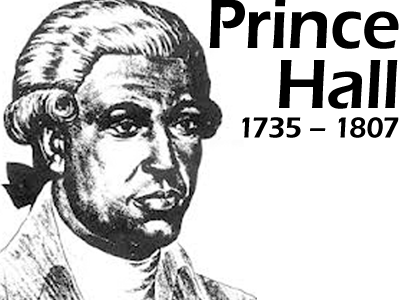THE HISTORY OF PRINCE HALL FREEMASONRY
The Beginning of Prince Hall Masonry in North America
Black Freemasonry began when Prince Hall and fourteen other free black men were initiated by members of Lodge No. 441, Irish Constitution, attached to one of General Gage’s regiments—the 38th Regiment of Foot, British Army garrisoned at Castle Williams Island (now Fort Independence), Boston Harbor on March 6, 1775. The Master of Lodge No. 441 was Sergeant John Batt. Along with Prince Hall, the others were Peter Freeman, Benjamin Tiber, Duff Bufform, Thomas Sanderson, Prince Payden, Cato Speain, Boston Smith, Peter Best, Fortin Howard and Richard Tilley. There is some variance in the spelling of the names, depending on the source. When the British Army left Boston, Lodge No. 441 granted Prince Hall and his brethren authority to meet as a Lodge and to go in procession on St. John’s Day. They were also given authority to bury their dead. However, they could not confer degrees or perform any other Masonic “work.”

African Lodge No. 1 was organized on July 3, 1775, with Prince Hall as Worshipful Master. Official acknowledgment of the legitimacy of African Lodge No. 1 was made almost immediately by John Rowe of Boston, a Provincial Grand Master for North America holding authority from the premier Grand Lodge of Freemasons, the Grand Lodge of England. He, too, issued a permit authorizing African Lodge No. 1 to appear publicly in procession as a Masonic body for the purpose of celebrating the Feast of St. John and to bury its dead.
By the end of the American Revolution, in 1781, American predomi¬nately white Lodges had begun declaring independence from the English Grand Lodge. They were not interested in granting a charter to Prince Hall or African Lodge. Although the members of African Lodge No. 1 were free men, black men were automatically assumed by the Masonic colonists to have “obligations” to masters. Thus, predominately white Lodges in America were not interested in reciprocal recognition with African Lodge, nor were they interested in bringing them under their jurisdiction.
Charter
Prince hall portraitOn March 2, 1784 and June 30, 1784, African Lodge No. 1 petitioned the Grand Lodge of England for a warrant (or charter) to organize a reg¬ular Masonic Lodge, with all the rights and privileges thereunto pre¬scribed. Prince Hall petitioned the Grand Lodge of England through Worshipful Master William Moody of Brotherly Love Lodge No. 55 (London, England) for a warrant or charter. The charter was prepared and issued on September 29, 1784, although it would be three years before African Lodge actually received it. The Grand Lodge of England assigned number 459 to African Lodge No. 1. Captain James Scott deliv¬ered the charter on April 29, 1787. Captain James Scott was Master of the Neptune, and also worked with John Hancock, who was one of the signers of the Declaration of Independence. By virtue of the authority of this charter, African Lodge No. 459 was organized one week later and began work as a regular Masonic Body on May 6, 1787. The warrant to African Lodge No. 459 of Boston is the most significant and highly prized document known to the Prince Hall Masonic Fraternity. It is also the only known charter in existence in America issued by the Grand Lodge of England.
Subsequent to establishing Lodge No. 459 of Boston, Prince Hall established African Lodge 459, F. &A.M. of North America at Philadelphia in 1797 and also a lodge at Providence, Rhode Island. Shortly thereafter he chartered Union Lodge No. 3 and Laurel Lodge No. 4 of Pennsylvania. These Lodges remained subordinate to the Mother Lodge in Massachusetts until December 27, 1815, at which time the three Pennsylvania Lodges met in general assembly and organized African Grand Lodge of North America with jurisdiction over the State of Pennsylvania and the South including the District of Columbia. Thus we have the succession of events leading up to the petitioning of the subject Grand Lodge in Washington, D.C., by the founders of Social Lodge.
